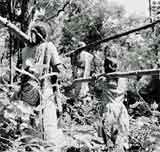A step forward
 the Union ministry of environment and forests ( mef ) has finally taken the first step towards enacting a biodiversity legislation. On October 27, 1997, Saifuddin Soz, the Union minister of environment and forests released to the press the report submitted by a 16-member expert committee headed by the renowned agricultural scientist M S Swaminathan. The team was set up in August 1997 by the mef to work out the draft outline of the legislation. If the Union cabinet approves it, the draft will be formalised by the law ministry and sent to Parliament for official stamp of approval. "It is far more acceptable than anything else that mef has shown us till date,' says R S Rana, head of the biodiversity wing of the World Wide Fund for Nature ( wwf ).
the Union ministry of environment and forests ( mef ) has finally taken the first step towards enacting a biodiversity legislation. On October 27, 1997, Saifuddin Soz, the Union minister of environment and forests released to the press the report submitted by a 16-member expert committee headed by the renowned agricultural scientist M S Swaminathan. The team was set up in August 1997 by the mef to work out the draft outline of the legislation. If the Union cabinet approves it, the draft will be formalised by the law ministry and sent to Parliament for official stamp of approval. "It is far more acceptable than anything else that mef has shown us till date,' says R S Rana, head of the biodiversity wing of the World Wide Fund for Nature ( wwf ).
This is the second draft that the mef has put together within a span of five months. The first was a document produced by the biodiversity team led by A K Ahuja, joint secretary, mef . It was presented at a national consultation meeting organised by the mef on June 10, 1997. The draft came in for sharp criticism from numerous quarters including experts on the subject, non-governmental organisations ( ngo s) and voluntary organisations representing local communities. The main grouse was that the process of developing the draft was not transparent. "The drafting was done behind closed doors by the ministry people and the end product was just not acceptable to any one else,' said Suman Sahai, convenor, Gene Campaign, an activist group in New Delhi. If the draft had been finalised, the only enabling authority concerning any issue related to biodiversity would have been the mef , complained critics.
In order to steer clear of controversy the second time around, the minister constituted a 16-member group under Swaminathan on August 13. This included scientists and technical experts (such as Sahai, a geneticist) along with officials representing various government agencies such as the departments of biotechnology, ocean development and the ministry of law. After three sessions of rigorous deliberations, the group handed over the report to the minister on October 7.
The draft makes an honest attempt to decentralise the ministry's control over bioresources. Both the present draft and the earlier one aimed at creating a national biodiversity authority. This is to be the nodal agency responsible for all matters related to conservation of biological diversity. It is also to ensure that a slice of the profits arising out of the commercialisation of the bioresources goes to local communities that actually possess the know-how.
But while the June draft laid down that this all-powerful national biodiversity authority would solely rest with members of different departments of the Union government, the October draft puts an equal number of government and independent representatives in the team (five and five). The chairperson, however, would still be appointed by the Union government. The new draft also emphasises the issue of benefit sharing with local communities, which was missing in the earlier draft. There is a specific provision for the setting up of a committee on access to genetic resources and benefit sharing "to ensure efficient discharge of these duties'. The stress in the previous draft was on conservation of biological resources. In the present draft, the term "conservation' is brought up only while mentioning the people, that is the local communities who are repeatedly acknowledged as the prime conservers.
There are special provisions directed at research institutes. The provisions stipulate that any transfer of bioresources to institutions
Related Content
- Action taken report by the District Magistrate and Collector, South 24 Parganas on steps taken to prevent coastal erosion, Sagar Island, West Bengal, 22/02/2025
- Order of the National Green Tribunal regarding fish sold in Assam contaminated with formaldehyde, 10/04/2024
- Order of the National Green Tribunal regarding protection of Sambhar lake, Rajasthan, 09/11/2023
- Accelerating the energy transition by rethinking power-system flexibility: imperatives for the G20
- District Magistrate Ayodhya report on damage to hydrolgy and drainage due to the construction of Sri Ram International Airport, Ayodhya, Uttar Pradesh, 03/03/2023
- State of global environmental governance 2022
